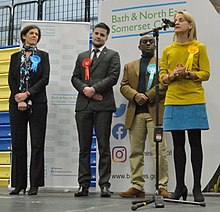
In politics, a rosette is a fabric decoration worn by political candidates to identify themselves as belonging to a particular party. The rosette, worn on the chest or suit jacket, will show the colour or colours of the political party that the candidate represents. Rosettes are worn by campaigning politicians in the United Kingdom, New Zealand and some other countries.
Standard colours and emblems
In the UK, the most commonly seen colours of rosettes are:
- Red for Labour
- Blue for Conservative
- Amber for Liberal Democrats
- Green for Green Party
- Yellow for SNP
- Red, white and blue for DUP
- Green and orange for Plaid Cymru
- Light blue for Reform UK
- Purple for UK Independence Party
- White for Yorkshire Party
In similar fashion, candidates wearing suits to their election counts will often wear a tie of their party's corresponding colour. Coloured flowers are also sometimes used, particularly in the case of the red rose as a symbol of the Labour Party; this has been common since the 1980s when leaders Neil Kinnock and Tony Blair encouraged their use, and Labour adopted the red rose as the party's logo.
Monster Raving Loony Party candidates may satirise the practice by wearing oversized rosettes of various colours.
History

When political parties emerged in the UK, they used different colours in different areas. This may have been for a variety of reasons, such as association of colours with leading families of the area and then the political parties they supported. In some areas, non-standard colours were worn up to around the 1970s as a local tradition. Major political parties have now standardised on the colours used nationally, a trend accelerated by the arrival of colour television.
The wearing of rosettes in and around polling stations is strictly regulated by the Electoral Commission. Rosettes can be worn by activist tellers working for the party and can display the name of a candidate, emblem or description, but cannot be oversized or display a political slogan, nor can tellers wear or carry anything else "that carries any writing, picture or sign relating to any candidate...apart from a rosette". In 2008, the Commission stipulated that rosettes greater than four inches in diameter were not allowed to be worn in polling stations.
In Labour and Conservative safe seats, a common saying is that a pig or monkey in a red or blue rosette would win an election in that seat (cf. yellow dog Democrat).
See also
References
- "Rosettes". Local Government Association. Retrieved 24 April 2023.
- Zetter, Lionel (1 September 2007). The Political Campaigning Handbook: Real life lessons from the front line. Harriman House. p. 141. ISBN 978-1-905641-34-5.
- "History of the Labour Party - Part 3". Labour Party. Retrieved 21 May 2016.
- Routledge, Paul (1999). Mandy: the unauthorised biography of Peter Mandelson. London: Simon & Schuster. pp. 147–148. ISBN 9780684851754.
Leigh Hatts, twice a Labour candidate in Christchurch, who wore a real red rose in 1974 and 1979...He simply didn't like rosettes, which he thought made candidates look like prize-winning cattle.
- ^ Kelly, Jon (3 May 2015). "The seats where Tories weren't blue and Labour wasn't red". BBC News. Retrieved 22 February 2016.
- "Why is the Conservative Party blue?". BBC Magazine. 20 April 2006. Retrieved 22 February 2016.
- "Guidance on the conduct of tellers in and around polling places" (PDF). The Electoral Commission. Retrieved 24 April 2023.
Tellers may wear coloured rosettes or a badge of a reasonable size, as this1.18 assists electors by making it clear that they are activists and not electoral officials. The rosette/badge may display the name of a candidate and/or an emblem or description; the rosette/badge should not bear a slogan and must not be oversized. Tellers must not wear, carry or display any headwear, footwear or other apparel that carries any writing, picture or sign relating to any candidate or party apart from a rosette.
- de Castella, Tom; Heyden, Tom (5 May 2015). "Election 2015: What CAN'T you do in a polling station?". BBC News. Retrieved 22 February 2016.
- Goodwin, Matthew; Milazzo, Caitlin (2015). Ukip: Inside the Campaign to Redraw the Map of British Politics. Oxford University Press. p. 15. ISBN 978-0-19-873611-0.
- Blythe, Daniel (2 April 2009). X Marks the Box. Icon Books Limited. p. 91. ISBN 978-1-84831-180-0.